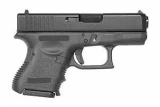Glock 22 Gen 4 vs Massachusetts Arms Wesson & Leavitt Revolver
Put handguns head to head to compare caliber and more.
|
$806.15
|
vs |
$0.00
|
| Handguns | Glock 22 Gen 4 | Massachusetts Arms Wesson & Leavitt Revolver |
|---|---|---|
| Summary | ||
| Rating | ||
| Rank | ||
| Action | Safe Action | |
| Caliber | .40 S&W | .31 Caliber |
| Capacity | 15+1 | 17+1 |
| Finish | Black | Stainless Steel |
| Sights | Fixed | Adjustable Open U - notch |
| Barrel Length | 4.49" | 23.37" |
| Weight | 40 oz | |
| Gun Type | Revolver | |
| Details | ||
| Brand | Glock | |
| Reviews | See 3 Reviews | N/A |
| Prices | ||
| MSRP | $789.15 | $0.00 |
| Used Price | $552.41 | $0.00 |
| Sale Price | $710.24 | $0.00 |
Handguns Descriptions
Glock 22 Gen 4
The GLOCK 22 Gen4, in .40, introduces revolutionary design changes to this model of perfection that the majority of law enforcement across the country put their trust in every day. The Modular Back Strap design of the G22 Gen4 lets you instantly customize its grip to adapt to an individual shooter's hand size. The surface of the frame employs the new scientifically designed, real-world-tested, Gen4 rough textured technology. Internally, the new GLOCK dual recoil spring assembly substantially increases the life of the system. A reversible enlarged magazine catch, changeable in seconds, accommodates left or right-handed operators. The G22 Gen4 .40 caliber retains the GLOCK accessory rail for your attachments.
Massachusetts Arms Wesson & Leavitt Revolver
he Wesson & Leavitt Revolver was a single action black-powder revolver made by Massachusetts Arms Company in Chicopee Falls, MA. The first arms produced by Mass Arms were percussion revolvers designed by Edwin Wesson (brother of Daniel Wesson) and Thomas Warner (who was the factory superintendent). The revolvers were produced under patents held by Wesson and Daniel Leavitt. The first guns produced in 1850 were the larger “Dragoon” sized revolvers in .40 caliber. Later in 1850, the firm introduced a “Belt” size revolver in .31 caliber. Both revolvers utilized side-mounted, back action locks that operated in a “single action” fashion. They had a hinged top strap that connected the barrel to the rear portion of the frame, which contained the lockwork. The barrel was held in a stationary and locked position by a swinging latch that secured the topstrap to the forward portion of the cylinder arbor pin. The guns had six shot cylinders with convex beveled fronts, and oval cutouts for the percussion cones, which entered the chambers at about a 30-degree angle. The coking action of the hammer rotated a back plate in the frame of the revolver. This back plate rotated the cylinder by way of a pin, which extended from the plate and engaged a hole on the rear face of the cylinder. A second, smaller pin would move in and out of the frame, engaging smaller holes on the rear of the cylinder that corresponded to each chamber, allowing for accurate indexing and lock up of the cylinder. The guns were manufactured with round blued barrels, case hardened frames and brass back straps and trigger guards, which were silver-plated. During the brief production run (1850-1851) of Wesson & Leavitt revolvers, Mass Arms produced about 800 of the larger Dragoon revolvers and approximately 1,000 of the Belt revolvers. Production ended during 1851 due to a successful patent infringement lawsuit that was filed by Samuel Colt.



















